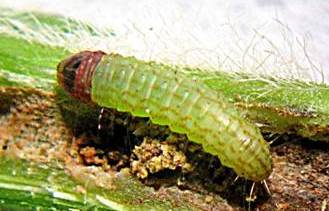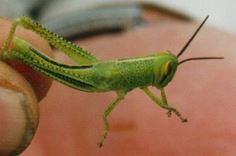Call Biosecurity Queensland on 13 25 23 if you see this pest Russian wheat aphid (Diuraphis noxia) has been found on over 1,400 square kilometres of land in the mid-north of South Australia. Russian wheat aphid is a major pest of cereal crops which injects toxins into the plant during feeding, retarding growth and killing the plant. Russian wheat aphid… Read more »
In response to the recent confirmation of the damage potential of green mirids in faba beans, Pulse Australia has successfully applied to the APVMA for a permit to allow the use of dimethoate for the control of mirids in faba beans (PER82378). The permit is active from 1 June 2016 to 31 May 2021, and is applicable in all states,… Read more »
Bean podborer (Maruca vitrata) have been observed in large numbers (>20/m2) in flowering/podding mungbeans planted from January onwards in the Burnett region. They are likely to be present in other coastal/subcoastal regions such as the Burdekin, Callide Valley and the Wide Bay/Burnett (particularly in late-planted crops), and to a lesser extent in the eastern Darling Downs, and Emerald in Central… Read more »
Two new insecticides have recently been registered to control Bemisia tabaci B-biotype in cotton. Product Insecticide group Active ingredient Pest Exirel® anthranilic diamide (Group 28) cyantraniliprole SLW, Helicoverpa, cotton aphid (suppression only) Starkle® neonicotinoid (Group 4A) dinotefuran SLW & green mirid Exirel® was registered for cotton use in the 2013/14 season, and Starkle® has been registered for the current cotton… Read more »
Over the past two winters, agronomists and growers have been asking whether the green mirids that they are finding in faba beans are doing any damage. Until now, the short answer to that was that we simply didn’t know. In 2014 Department of Agriculture and Fisheries (DAF) Entomology conducted a preliminary trial to determine if green mirids could cause the… Read more »
Emerging and vegetative summer crops in close proximity to unharvested winter crop are at risk of thrip damage, but the damage is largely cosmetic and rarely warrants treating. Thrips breed up in winter cereals, and particularly after rain, will move out of the winter crops in huge numbers. Most of you will be familiar with the joys of thrips biting… Read more »
Where there is a history of soil insect damage resulting in poor crop establishment a pre-sowing inspection of the affected fields is warranted to determine the likely risk to the upcoming summer crop. Grain baits are an effective way of monitoring for soil-dwelling insect pests of summer crops, and is preferable to sampling with a shovel, which is both time… Read more »
Helicoverpa armigera active now. This spring a number of agronomists have just started monitoring pheromone traps across the northern region, and the results from the past two weeks illustrate how useful pheromone traps can be. Over the past 1-2 weeks, the traps are catching relatively high numbers of Helicoverpa armigera, and low catches of H. punctigera. In September it is generally assumed that… Read more »
There is an understandable level of concern about how best to manage etiella (Etiella behrii) in summer mungbean crops following the unexpectedly high etiella infestations (and corresponding seed damage and contamination) in spring mungbean crops on the Downs and in Central Queensland and North Western New South Wales. Responding to the etiella threat without reacting prematurely and creating more pest… Read more »
Locusts and grasshoppers are active across large areas of western Queensland and NSW and central Queensland. Reports of the Australian Plague Locust, Migratory Locusts, Yellow winged locust and spur-throated locust have been received from areas around St George to the Central Highlands during January and early February. It has been several years since we have seen such high locust and grasshopper… Read more »


